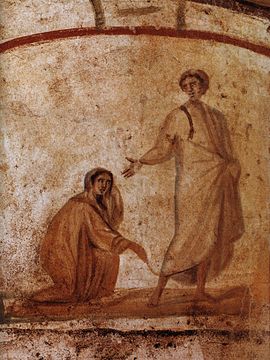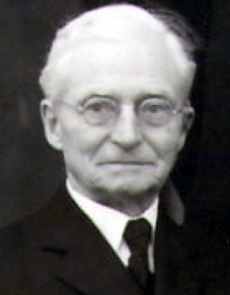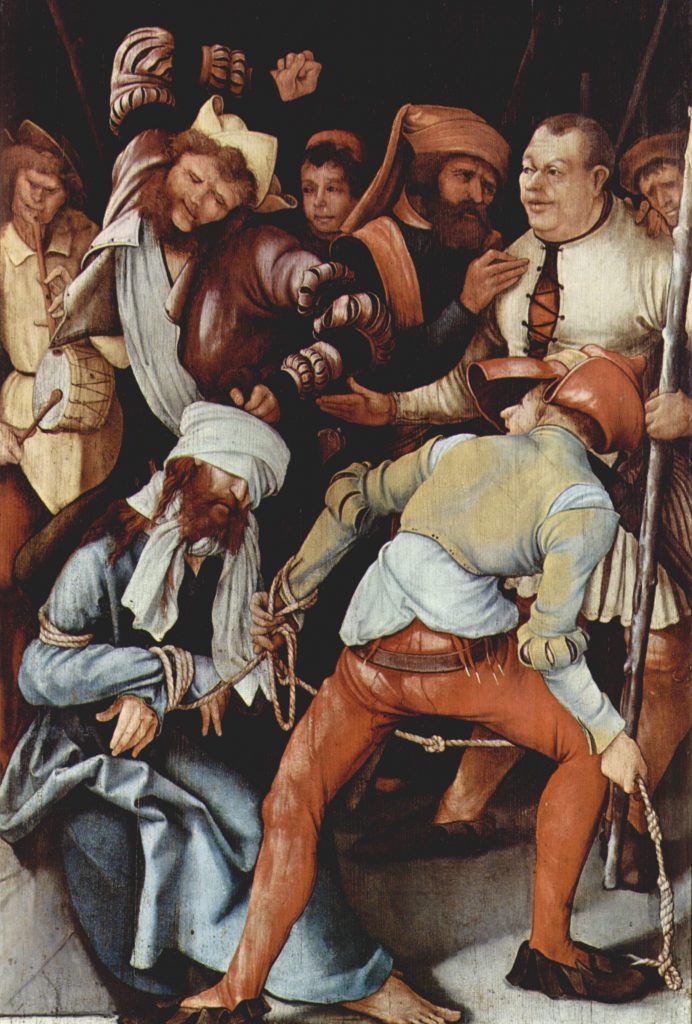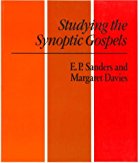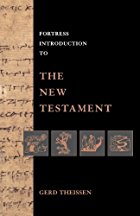Critique of the Gospel History of the Synoptics
by Bruno Bauer
Volume 2
—o0o—
87
§ 35.
The Healing of the Paralytic.
Matthew 9:2-8.
The boldness with which Jesus exclaimed to the paralytic, “Child, your sins are forgiven!” seemed like blasphemous presumption to the present scribes. Jesus recognized in their hearts *) their thoughts and said to them, “Why do you think such things in your hearts? What is easier to say to the paralytic, ‘Your sins are forgiven,’ or:
*) Only Mark 2:8 has the addition: τω πνευματι for he was the first to feel the need to explain the miraculous fact that Jesus recognized the secret thoughts of the scribes. Luke omits the addition, he only says επιγνους τους διαλογισμους αυτων, and Matthew (9:4) even says: “And Jesus, knowing their thoughts” – εἰδὼς; for the later generations it goes without saying that Jesus instantly understood people’s inner thoughts.
88
Rise, take up your bed and walk?” But to show them that as the Son of Man he had the authority on earth to forgive sins, he said to the paralytic, “I say to you, rise, pick up your bed and go home.” “And immediately he rose up, took up his bed and went out before them all. *)” Thus ended the story, according to Mark 2:12, and the people were amazed and praised God, saying, “We have never seen anything like this!” Luke confused the conclusion by his redundancy: first, saying that all were amazed, then that they praised God, and finally that they were filled with fear, saying, “Today we have seen strange things.” He also introduced confusion by saying earlier (Luke 5:25) that the healed man went home, praising God δοξαζων τον θεον. This praise was originally only intended for the conclusion, as the people saw the formerly paralyzed man leave the house, healed and healthy (Mark 2:12 εξηλθεν εναντιον παντων).
When Mark notes at the end of a miracle story that the people or the disciples were amazed **), and often uses vivid colors to paint their amazement, it was once thought that this was proof that he wrote after Matthew and Luke and had no choice but to exaggerate the short, casual and unguarded reports of his predecessors. This was very unjustified! On the contrary, we have just seen how Luke has overloaded and confused the simple and natural conclusion of his predecessor’s account. Matthew had to reveal to us through his clumsiness in changing the conclusion of the account of the calming of the storm that he could no longer find himself in the representation of his predecessor, or at least could not leave it unchanged. He will prove to us again shortly that by transcribing the writing of Mark and changing its details, he did not necessarily improve it from a pragmatic perspective. He will show us this again, also in the concluding remarks to accounts of miracles.
*) Mark 2, 10-12: λέγει τα παραλυτικώ· σοι λέγω, έγειραι, άρον τον κράββατών σου και ύπαγε εις τον οίκόν σου, και εγερθείς ευθέως και άρας τον κράββατον εξήλθεν εναντίον πάντων. Luke 5, 24 hat ſtatt zpáßßatov zhuvidiov. Matth. 9, 6 shivrv. Compare temporarily John 5, 8, 9: λέγει αυτώ ο Ιησούς, έγειραι, άρον τον κράββατών σου και περιπάτει, και ευθέως εγένετο υγιής ο άνθρωπος» και ήρε τον κράββατον αυτού και περιεπάτει. John 5. 5, 14 μηκέτι αμάρτανε, ίνα μη χείρόν τί σοι γένηται. Further V. 18 ίσον εαυτόν ποιών τω θεώ compare with Mark, 2, 7 τί ούτος λαλεί βλασφημίας και τις δύναται αφιέναι αμαρτίας, ει μή είς ο θεός; Luke 5, 21 ει μη μόνος ο θεός; Matth. 9, 3 let the scribes say only: οὗτος βλασφημεῖ; he doesn’t dwell on the individual anymore because he believes every reader will interpret the meaning of the reproach as he himself does.
**) See C. 4:41: “Who is this, that even wind and sea obey him?” Mark 5:20: “And they were amazed beyond measure, saying, ‘He has done all things well. He even makes the deaf hear and the mute speak.’” Mark 7:37: “And they were astonished beyond measure, saying, ‘He has done all things well. He even makes the deaf hear and the mute speak.’”
At times, Mark omits to mention that everyone was amazed, but never without reason; he then creates another contrast at the end or intends to connect the following event closer to the miraculous deed. For example, after the Sabbath healings, the Pharisees “immediately” decide to destroy Jesus (Mark 3:6). Also, in Mark 1:34 and 3:12, he doesn’t want to be made known by demons. After the miraculous feeding (Mark 6:45-46), he immediately forces the disciples to go ahead of him across the sea, and he himself escapes to the mountain. After healing the deaf-mute demoniac, the disciples ask in Mark 9:28 why they couldn’t cast out the demon. Peter’s mother-in-law, freed from fever, waits for the guests in Mark 1:31. In contrast, the amazement of the people is expressed strongly elsewhere! Also, compare the amazement of the disciples in Mark 6:51!
89
The matter is to be understood quite differently, and this – the only correct – interpretation is not unimportant for the development of criticism, as it is fatal to the miracle stories. If Mark lets the people or the disciples be beside themselves with amazement at the miraculous deeds of the Lord, this amazement is the objective and plastic expression of what was happening in the view of the community and the writer who shaped it, as faith in the heavenly power of the Redeemer became historical belief and created a new, wonderful history. The religious self-consciousness itself was beside itself, and with every new enrichment of the Gospel miracle story it was beside itself, and although the miracle power of the Lord was certain to the writer who worked for the community, it was still an involuntary feeling that these specific types of miracles were new, and his feeling, as well as the impression these reports made on the community, had to be incorporated into the historical narrative itself. The amazement of the crowd and the disciples is the amazement and restoration of the original evangelist and his contemporaries.
90
Luke writes down the formulas that express this amazement without significant changes, but Matthew proves the correctness of our interpretation through the changes he attempted to make to the original account. Either he suppresses the remark that Jesus’ deed aroused admiration (as in the account of the healing of the Gadarene demoniac), or he exchanges his predecessor’s strong expressions (“they were amazed,” “they were beside themselves”) for the milder expression that they were simply surprised. When Mark reports that even the disciples were amazed, he says that “the people” in Jesus’ surroundings marveled (as in Mark 8:27 and 14:33). And when finally in Mark’s account the people are amazed at the wondrousness of the deed in general, Matthew says that they were amazed at the power of this particular deed. That’s how he did it this time. To the scribes Jesus said, “So that you may see that the Son of Man has authority on earth to forgive sins, I say to you, rise up, take up your bed, and go home.” Accordingly, in Matthew 9:8, the people praise God for giving “such” power to people. And now, “people!” It is not so much the miracle-working power of Jesus that is the cause of amazement, but rather the fact that in Jesus’ power the whole of humanity is considered, elevated, and glorified by God. When Matthew wrote, the world of wonder was already established to such a degree and the view already so deeply rooted that it seemed inappropriate to make a big deal out of the miracle.
91
If we are asked to discuss the so-called credibility of the report, the theologian in us and the theologian outside who scrutinizes us demand it. Well then! The amazement of the crowd is depicted, but the crowd itself only came together in such great numbers that it blocked the way to the house where Jesus was staying and prevented the faithful bearers of the sick man from reaching him, because it wanted to take advantage of Jesus’ presence and insisted that he leave as quickly as he did during his first visit to Capernaum. For the same reason, they absolutely wanted to bring the sick man to Jesus. However, we have already recognized the first visit, that is, the one described by Mark, as the work of the writer. Furthermore, how could Jesus know what the scribes were thinking in their hearts? Jesus knows because that’s what Mark wants, because the evangelist wants to report the following speech about forgiveness of sins and miraculous powers, and the scribes must take offense at it this time because the arrangement of this report demands it, namely, that the hostility of the scribes should first be expressed as inner dissatisfaction and then gradually become more evident until finally (Mark 3:6) the opponents of the Lord conspire to bring about his downfall. As for how the bearers could bring their stretcher onto the roof of the house, we will not ask, as the apologist will torture us with the excuse that they took a – at any rate, very long and arduous – detour; but how they could break open the roof and enter the room where Jesus was, without damaging the assembly in the room or fatally injuring anyone’s head, no one will tell us, at least no one who would try to persuade us that we should consider the report as credible. Operations of this kind, such as breaking open a roof over a room filled with people, only cease to be dangerous when they are carried out in the realm of ideal perception.
92
In Jesus’ words, “which is easier to say, ‘your sins are forgiven’ or to say, ‘get up and walk’?” the most convincing proof for the assertion that he performed miracles had to lie if they were really his words. But to believe this is hindered by nothing less than their content. The scribes took offense at Jesus speaking as if he had the power to forgive sins. Jesus now wants to prove that he does indeed possess and can exercise this power: “For which is easier, to forgive sins or to perform miracles? Clearly the former; therefore, if I can do the more difficult, as I will now show, then it cannot be doubted that I also have the authority for the easier.” The conclusion is understandable, but for whom? For the consciousness to which the Savior’s miraculous power is the strongest and compelling proof of his authority. However, this consciousness has only formed him, not Jesus! As understandable as he may be, he is incorrect, untrue, because the power of the spirit to forgive sin and to undo what has been done is surely greater than the most enormous miracle, which only suspends a natural law, as the spirit surpasses nature infinitely through its power, interiority, intensity, i.e. through its ability to resist. The man who shook the world by expanding self-awareness to infinity and revealed it as the power over sin, this man could never have made the statement that the miracle was greater than the act of forgiving sins. It was only in the later community that the saying and the occasion that brought it forth were formed. When, namely, the religious-historical view of Jesus’ authority to forgive sins wanted to become truly certain and to view its proof through the power of miracles in one focus, it was indeed appropriate that a sick person be brought before the Lord, since illness was considered a punishment for sin and in its healing the abolition of sin also appeared externally, just as Jesus most clearly demonstrated his power over sin when he performed what was perceived as the more difficult task, namely, lifting the visible appearance of sin. It is also very appropriate and a correct instinct of view that the scribes are set up as opponents; to Jewish consciousness, it indeed seemed impossible that the spirit could gain mastery over its inner determinacy, including sin.
93
If the point of the report is based on the assumption that illness is a punishment for sin *), then the result of our criticism relieves us of the question of whether Jesus assumed a positive connection between sin and illness. We do not know how he saw the matter, but we do see from the Gospels that in the early church the Jewish view of that connection still held, at least to the extent that it was still accepted unreservedly when needed for pragmatic reasons.
*) Weisse, I, 480 notes that the report does not assume that “every individual illness is a specific punishment for sin.” That is correct, but does not address the matter and does not negate the actual assumption. It was only the reasonable uncertainty and inconsistency of the Jewish consciousness if that view was not taken out of its generality and applied to each individual case. The embarrassment of this application to the individual would have entangled the legal consciousness in too many contradictions and would have led to the dissolution of the view earlier than it actually happened. The evangelists assume lengthy and ingrained illnesses when they use the Jewish view for their narratives.
The story of the man born blind in the fourth Gospel provides us with evidence that the difficulties of the Jewish view, when applied to individual cases, were not hidden and gave rise to casuistic questions. A similar proof is provided by the Gospel of Luke. Once people come to Jesus and report to him about the Galileans whom Pilate had killed while they were offering sacrifices. Jesus answers, “Do you think that these Galileans were worse sinners than all the other Galileans because they suffered this way? No, I tell you; but unless you repent, you too will all perish. Or do you think that those eighteen on whom the tower in Siloam fell and killed them were worse offenders than all the others who lived in Jerusalem? No, I tell you; but unless you repent, you will all likewise perish. (Luke 13:1-5) The story tells us nothing about those Galileans. Of course, Olshausen *) says, “among the countless horrors that the Romans committed against the Jews, the slaughter of some unknown Galileans was like a drop in the ocean.” If this is so and no one can find the drop that has disappeared into the sea, then Luke would have known nothing about Pilate’s act, just as he knew nothing about the eighteen who were killed by a tower in Jerusalem. But the statement of Jesus, which referred to these accidents, has preserved the memory of them! Now, finally, make it understandable to us how a saying like this, a saying that truly has no such significant content, could have been preserved until the time of Luke – and even in tradition? The saying is freely formed and formed by Luke himself only in the present context, since before and after that it was said that one had to get one’s affairs in order and repent before it was too late. Before: if you go with your adversary to the magistrate, make an effort to settle with him on the way, lest he drag you to the judge; after: if the fig tree does not bear fruit, it will be cut down (Luke 12:58-59; 13:9) **). In the middle, Luke placed a saying that recommends the same consideration for the end, and is only different in its starting point from the other two, just as they differ from each other with regard to the epigrammatic preparation and the starting point.
*) B. C. I, 639.
**) Even the construction of the sentences corresponds to each other: Luke 13:5: ἀλλ’ ἐὰν μὴ μετανοήτε, πάντες ὡσαύτως ἀπολεῖσθε; Luke 23:9: εἰ δὲ μήγε, εἰς τὸ μέλλον ἐκκόψεις αὐτήν.
95
For the saying that concerns us here, Luke used the casuistic question that arose from the dissolution of the legal consciousness, namely the question of whether the misfortune is truly a punishment for sinfulness and proves the guilt of the suffering, since there are so many sinners running around who are spared from all misfortune. No, says Luke, their punishment will catch up with them in the end.
The apologist may still answer the question of how Jesus could immediately rebuke the people who innocently brought him the news of Pilate’s deed: Do you think these Galileans were especially sinful? At least he must answer the question, i.e., become a poet and create a new story if “credibility” is to be maintained. We have answered the question by saying that the address breaks out so prematurely because Luke is only concerned with this punchline and the occasion only needed to be mentioned as far as the reader needed to know to which event the saying referred.
——————————

